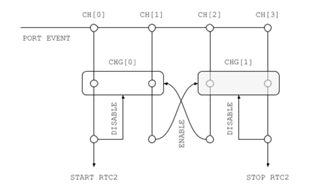Hello!
I want meashure pulse time via input capture.
I configured NRF_P0, NRF_GPIOTE, NRF_PPI and NRF_TIMER1.
NRF_P0->PIN_CNF[4] = 0x0000000C; NRF_GPIOTE->CONFIG[0] = 0x00010401; NRF_GPIOTE->CONFIG[1] = 0x00020401; NRF_GPIOTE->INTENSET = 3; NRF_GPIOTE->EVENTS_IN[0] = 1; NRF_GPIOTE->EVENTS_IN[1] = 1; NRF_PPI->CH[0].EEP = (uint32_t)&NRF_GPIOTE->EVENTS_IN[0]; NRF_PPI->CH[0].TEP = (uint32_t)&NRF_TIMER1->TASKS_CAPTURE[0]; NRF_PPI->CH[1].EEP = (uint32_t)&NRF_GPIOTE->EVENTS_IN[1]; NRF_PPI->CH[1].TEP = (uint32_t)&NRF_TIMER1->TASKS_CAPTURE[1]; NRF_PPI->CHENSET = 3; uint32_t err_code; NRF_TIMER1->TASKS_STOP = 1; NRF_TIMER1->MODE = 0; NRF_TIMER1->BITMODE = 3; NRF_TIMER1->PRESCALER = 0; NRF_TIMER1->TASKS_CLEAR = 1; NRF_TIMER1->SHORTS = 3; NRF_TIMER1->CC[0] = 0; NRF_TIMER1->INTENSET = 0x10000;
It work fine, but in datasheet I found next text:
Only one GPIOTE channel can be assigned to one physical pin. Failing to do so may result in unpredictable
behavior.
If using two GPIOTE channels with one pin is prohibited, then how should I measure the pulse duration without constantly reconfiguring the input capture?
And is it really impossible to use two GPIOTE lines with one pin?


